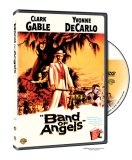It’s really hard for me to review films such as this one. On the one hand, I firmly believe in film preservation, and the importance of not shying away from history, no matter how painful it may be. On the other hand, it’s difficult for me to enjoy a film that so casually deals with the trade of humans. Band of Angels tells the story of the daughter of a plantation owner who is sent away to school. Her father is a good and kind man, for he has never beaten his slaves. When he falls deathly ill, she rushes back…to the plantation to be by his side. Upon his arrival, she finds her father dead, and slave traders waiting for her. As it turns out, her mother, which she has never met, was a “negro”, which means that she is to be sold at market with the rest of the slaves.
Starting to see why I was so uncomfortable now? The thing is, I can see the noble intentions behind this film, originally released in 1957. Clearly, this is a film that means to convince audience members that slavery and racism are wrong. However, it’s hard for me to hear that message when the dreaded “n” word is being thrown around so much. To be fair, the second half of the film is much more friendly for modern audiences, but I just can’t say that I felt right about watching this thing. It’s a shame too, because both Clark Gable and a very young Sidney Poitier have major roles which they handle quite well.
Audio
The disparity between the score and the dialog is pretty dramatic. I understand that it was the style of the day for the film score to be loud and powerful, but the track here is really quite overwhelming. In order to hear the dialog clearly, viewers must deal with music cues so loud that it sounds like you are actually on the sound stage while the orchestra is playing. It’s simply too much, especially for a Mono soundtrack to handle. There are just too many demands on the center speaker all at the same time. The highs and lows of the volume should be much more even.
Video
I was expecting this transfer to show its age more than it does. Colors are vibrant, and blemishes are minimal. There is some grain, but most of it just adds to the classic feel of the film. I was distracted, however, by the fact that some shots looked better than others in the very same scene. It looks like this problem has to do with the quality of the film in one camera being different than the quality of the film in another. Whatever the reason, it proves to be a real distraction in the affected scenes. Luckily, those scenes are merely sporadic, leaving the majority of the film to be quite easy on the eyes.
Special Features
There is only one extra included here, the original theatrical trailer. Luckily, this is one of those great classic trailers that starts off with a scene from the film, then the camera pulls back to reveal the whole of the soundstage the scene is being filmed on. When the director yells, “cut!”, Clark Gable turns to the screen, and says “Oh, hi. I’m Clark Gable.” As campy as this kind of thing is today, I’ll bet women swooned over that little trick back in the day. That’s great stuff. If you only have room for one extra feature on a disc, that’s a pretty fun one to have.
Conclusion
Clearly, both Gable and the studio were thinking about pulling in some more of that Gone With the Wind money when they partnered up to film this movie. It’s a noble effort, but there’s no way this film could have achieved the kind of success that came with Wind. In fact, I would classify Gone With the Wind as downright subtle in its tone compared to the way this piece beats the viewer over the head with its message of the wrongs of racial inequality. I respect the message, but the way that it has been told just didn’t agree with me.
Special Features List
- Trailer






